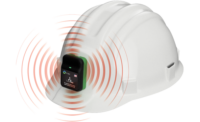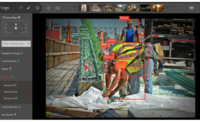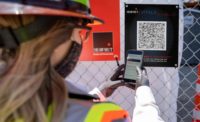The growth of jobsite automation has come in fits and starts over the past decade, with a few successful pilots and deployments scattered in an industry waiting to see what sticks. Gilbane Building Co. has decided to make the jump from pilots to full deployment of a jobsite robotics platform it has been developing in a joint venture with robotics startup NeXtera Robotics.
“A robotic solution has to do a thing that people don’t want to do, at a time they don’t want to do it, at a frequency that wouldn’t be a hindrance,” says Mike McKelvy, CEO and president of Gilbane. “It has to be autonomous, not dependent on a human to drive it around.”
The venture's efforts to develop robots geared toward construction practices appear to have borne fruit.
Gilbane is already using small rover robots that can document project as-builts on a daily basis, giving site supervisors and virtual design and construction (VDC) teams key intelligence on what’s getting done on site. With a successful pilot completed on a jobsite, the robots are likely the first hardware iteration of a larger platform. The company’s 50-50 joint venture with NeXtera also intends to eventually commercialize its robotics platform.
Wheeled and Treaded Robots
Nextera already had developed a software library for industrial robots when Gilbane showed up, but the chance to develop its platform alongside a contractor presented a unique opportunity, explains Lana Graf, the Boston-based company’s founder and CEO. “[Our platform] combines the most advanced AI practices that are built on deep-learning algorithms, and it is hardware agnostic,” she says. “For now we have a set of wheeled and treaded robots that share the same brain, with everything running on the cloud. But for us the big moment was making this platform accessible to the construction industry.”
The robotic hardware itself is not the main focus, Graf says, but rather just the current way of ingesting the vast amounts of project data needed to further train out NeXtera’s algorithms. Future robots could take many different shapes and sizes, but would all be trained on navigation and site-awareness data from earlier versions. Neural networks trained on thousands of trips around construction sites not only are developing the ability to independently navigate sites but also to identify and classify everything they see—from workers’ personal protective equipment to the different mechanical-electrical-plumbing components running throughout the site.
Earlier this year, NeXtera’s small rover robots were deployed on 225 Wyman, a 500,000-sq-ft laboratory and office project in Waltham, Mass., where Gilbane serves as construction manager. Two robots were on the site, one a wheeled model and the other with treads. Both robots were able to autonomously navigate the unfinished site, including a loading area of uneven crushed gravel, and the treaded robot was even able to climb staircases. The wheeled robot requires a human-operated elevator to change floors, at least for now.
Despite their regular rounds across the site, the robots were largely unobtrusive, and didn't require humans to clear paths for them in advance or rescue them when they became stuck, says Alex Chryssis, Gilbane senior project executive for 225 Wyman. “Instead of having a project engineer or superintendent out doing photo documentation day-to-day, we could have these robots that go around when the jobsite clears at 5 pm,” he says.
“The robot goes around and documents the site, then dumps [the data] all onto a point cloud system," Chryssis adds. We can have any of our as-builts only a click away.”
Chryssis says they also ran the robots throughout the day, and there were no issues of interference with trade workers. “What’s great is we can get 400 pictures a day uploaded to the website rather than sending someone out there to take 10 to 20 pictures a day,” he says. “We have the whole building, floor-by-floor, documented. It does the floors and ceilings as well, everything is covered.”
While this is only the first application for NeXtera robots on Gilbane projects, project team members are already seeing benefits from the extra documentation, according to Eric Cushman, operations manager of Gilbane’s Connecticut business unit. “Our senior general superintendent is stuck in meetings all day long, but now he can log into the database, see what areas are complete, and if there is a lag in an area, he can send more manpower if there’s a schedule implication,” he explains.
Photos and point-cloud scans of the inside of walls before they are closed up have proven invaluable, as later in the project workers have needed to confirm mechanical-electrical-plumbing installations. Cushman notes that the relatively low cost-per-robot is easily made up in this time savings and clash-detection. “This is not a six or seven-figure robot,” he says. The cost of each NeXtera robot was not disclosed.
Many Possible Uses
While the robots have proven useful in this one application, McKelvy says it is only the first of many possible uses, including in targeted environmental monitoring and even integration into jobsite security systems. “As we deploy these robots across Gilbane over the next year, we could see them tailored to a project,” he says. “We’re not just throwing another piece of hardware or software at [our VDC teams], we’re letting them work with it themselves.”
NeXtera is also looking to broaden its platform well beyond basic site documentation. “Our robots are a fleet of autonomous [machines], they can do anything without intervention,” says Graf. LiDAR units on the robots allow them to navigate sites, and with every deployment the machine learning algorithms underpinning their navigation grow more refined, she explains.
And new applications, such as providing live comparisons between reality captures of the site and the project’s BIM are not far off either, Graf adds. “We call this the digital bridge," she says. "Everyone in different offices: insurers, construction companies, can have a window into the location.”
Gilbane already has plans to bring the NeXtera robots to projects in New York City and Chicago later this year, with more deployments scheduled for 2022.
“It’s not like this was just going be a boutique, high-level thing to put on a couple of projects,” says McKelvy. “It’s got to be effective to add value. But when you compare what a robot is doing compared to what it would take two or three VDC people to do, it’s very economically feasible.”








